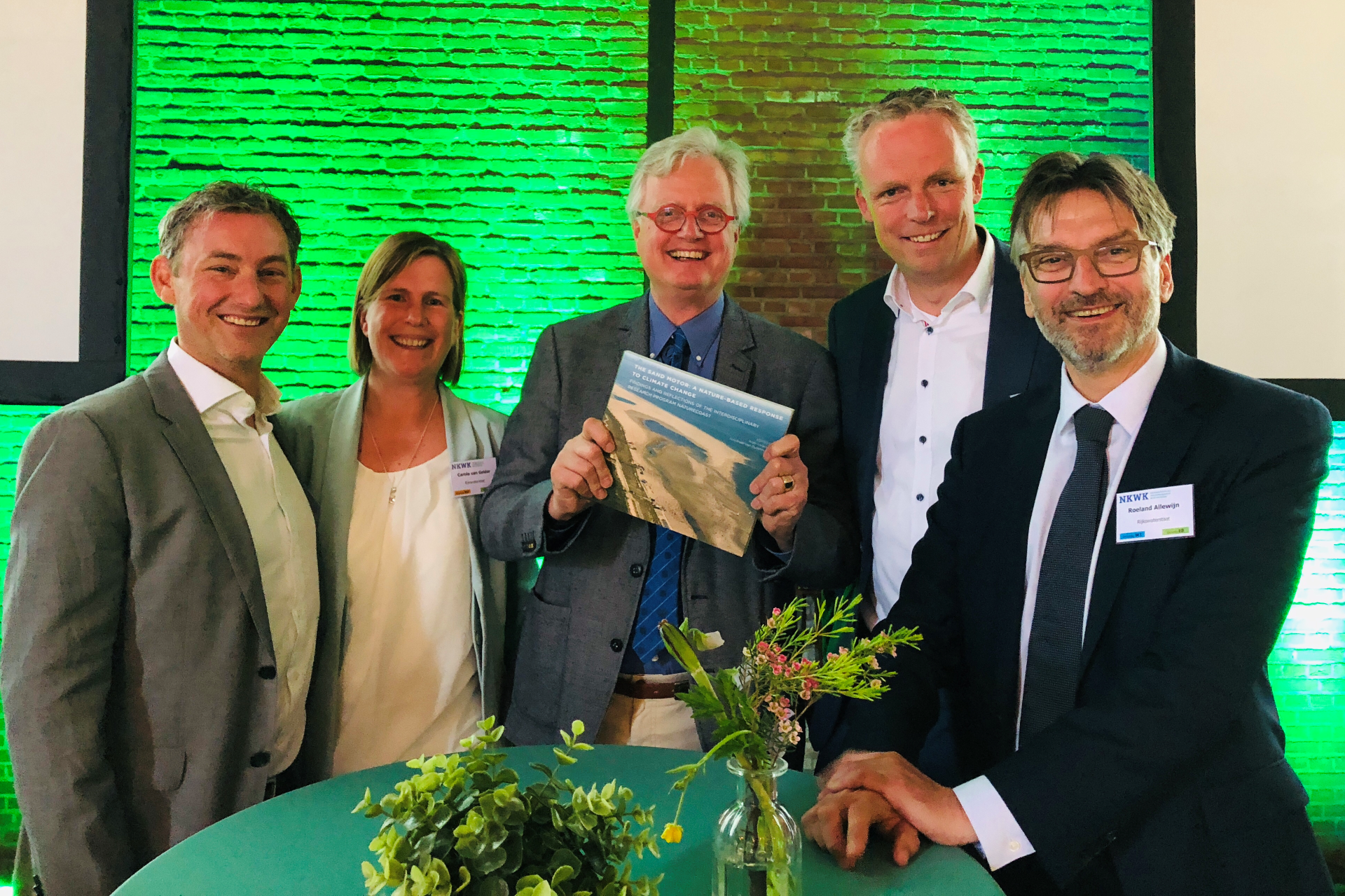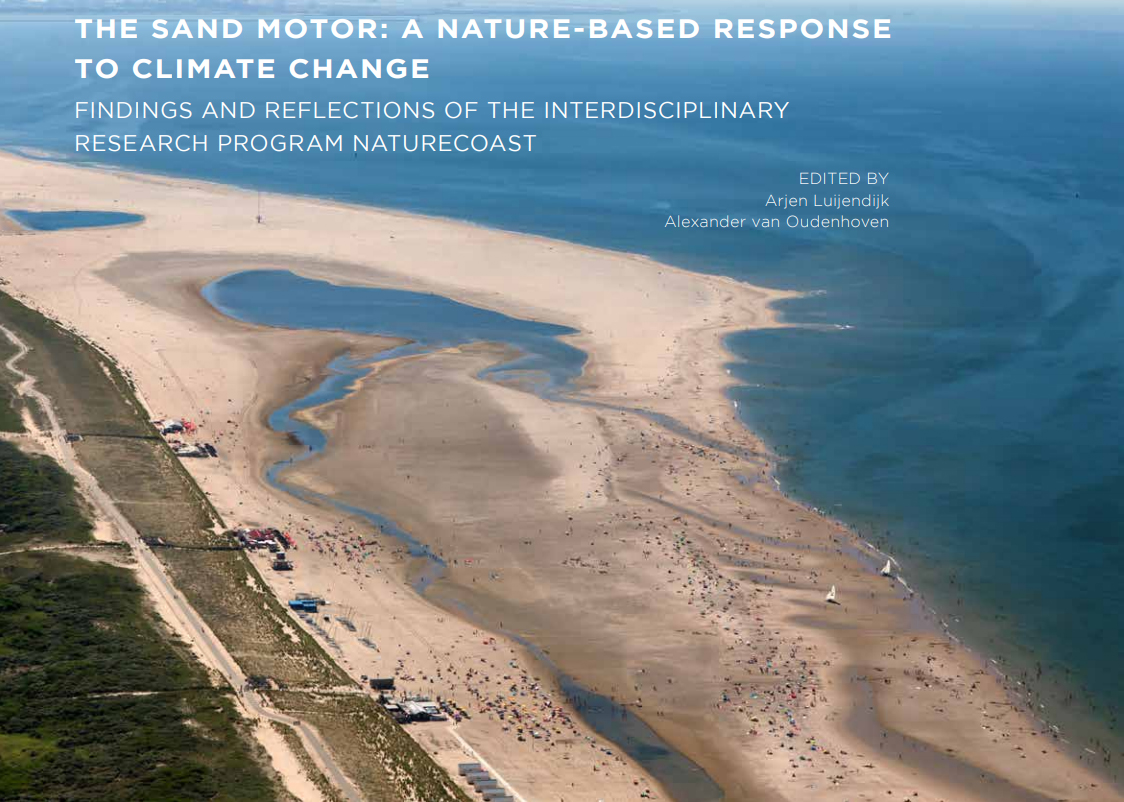The Sand Motor review: results and reflections on the NatureCoast programme
How can the Dutch Sand Motor help nature protect the Dutch coast? And can this knowledge be used to combat coastal erosion in Jamaica? The newly published ‘The Sand Motor: a nature-based response to climate change’ outlines the most important results and reflections on the multidisciplinary NatureCoast programme which ran from 2013 to 2017. The first copy of the book was presented to delta commissioner Peter Glas during the NKWK congress.
Living Lab on the coast
In 2013 NatureCoast, led by now emeritus professor of hydraulic engineering Marcel Stive (TU Delft), started to collect data to gain an insight into the behaviour and effects of large-scale sand suppletions. The Sand Motor, the artificial peninsula off the coast at The Hague, became a ‘Living Lab’ where researchers could take measurements and test their theories.
The main purpose of the Sand Motor is to use the powers of nature – waves, wind and currents – to carry the sand of the peninsula to places where it is needed. But apart from coastal protection the Sand Motor also enables the formation of a new natural landscape which also offers new recreational opportunities. In order to do justice to the many different facets of the project the NatureCoast programme was multidisciplinary from the outset.
‘Integral approach’
Twelve PhD candidates and three postdocs from different universities and disciplines carried out research in six different areas: coastal safety, dune formation, marine ecology, governance and hydrology and geochemistry. Apart from knowledge institutions companies and other end users also formed part of the consortium so as to bridge the gap between fundamental research and practical user requirements.
That cooperation proved invaluable, said Arjen Luijendijk, who helped compile the book. Postdoc Luijendijk was responsible for the integration of the six scientific projects conducted by the PhDs and gathered the interdisciplinary data on the Sand Motor.
‘This book presents the many facets of the Sand Motor but we also hope it shows the added value of cooperation and multidisciplinary research and how these will eventually benefit society,’ Luijendijk explained.
To demonstrate the importance of cooperation each chapter of the book consists of a dialogue between the NatureCoast researchers involved and the end users of the information.
Internationale cases
The research team also looked into the possibility of exporting the Sand Motor concept to other countries. It found that the Dutch solution is not one that will work for every coast in the world. However, the knowledge that has been gathered is already being used abroad to design the kind of coastal protection that will work in a local context.
The NatureCoast researchers have been actively involved in the design of a Sand Motor-like solution at Bacton, England, for example. This sandscaping scheme will take place in the summer of 2019.
Partners
The NatureCoast consortium is made up of six universities (TU Delft, Universiteit Utrecht, Technische Universiteit Twente, Universiteit Leiden, Wageningen University and NIOZ), but also includes end users such as knowledge institutes Deltares en Imares, the Provincie Zuid-Holland, Rijkswaterstaat, Natuurmonumenten, consultants (RHDHV, Arcadis, Witteveen & Bos) and off shore contractors Boskalis and Van Oord. The research is funded by NWO-TTW.
TU Delft contributors to the programme include:
- Marcel Stive
- Stefan Aarninkhof
- Arjen Luijendijk: post-doc Global physical feasibility of mega-nourishment concepts.
- Max Radermacher: Impact of sand nourishments on hydrodynamics and swimmer safety
- Bas Huisman: On the redistribution and sorting of sand at nourishments
- Bas Hoonhout: Aeolian Sediment availability and Transport.
- Lotte Bontje: Narratives of the sand motor and insights into the positive spirit around the pilot project.
Other contributors to the book include Peter Herman, Mark van Koningsveld, Jill Slinger, Matthieu de Schipper and Kees den Heijer.

